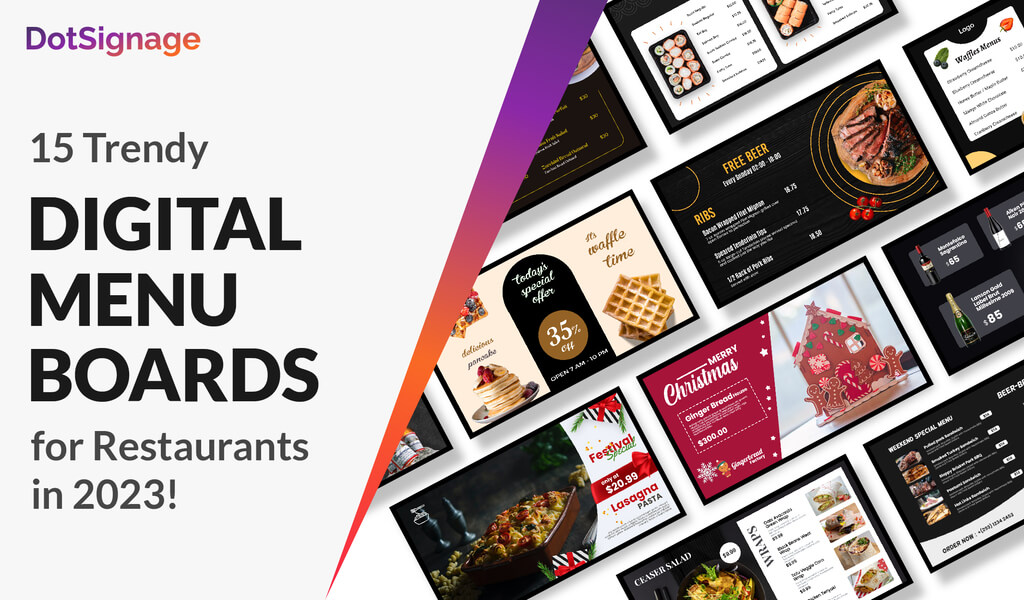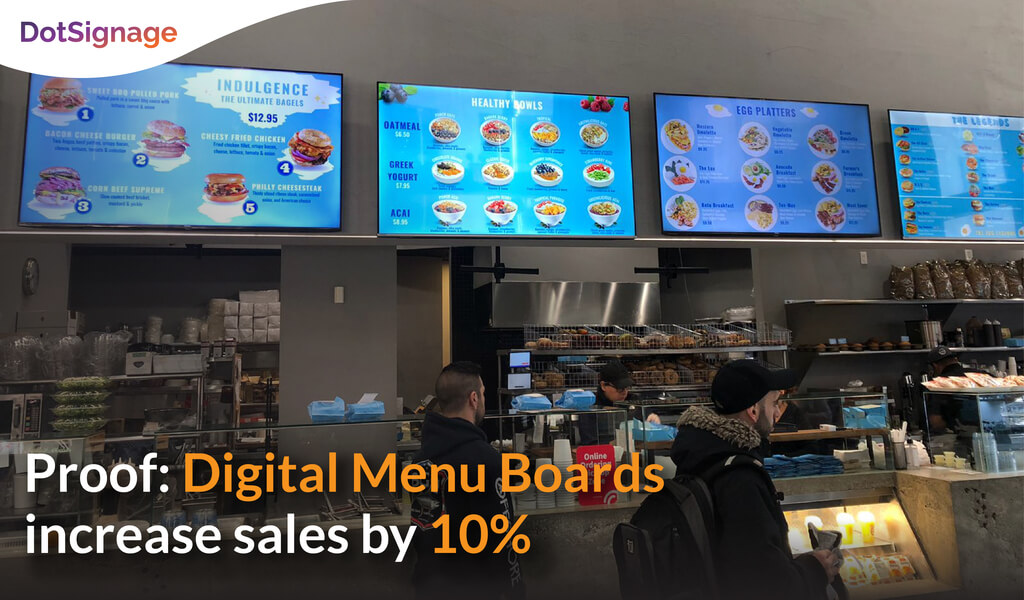New restaurants keep popping up all the time, offering lots of different places to eat. What really matters in the end is how tasty the food is and how well you can attract customers to your restaurant.
That said, digital menu boards are a secret ingredient that can help you stand out in the competition.
As Bill Gates famously said, “The advance of technology is based on making it fit in so that you don’t even notice it, so it’s part of everyday life.”
Image visuals tend to grab 35% more views than text-based information
Envision captivating your customers instantly with vibrant visuals, mouthwatering imagery, and dynamic content. It not only displays your offerings but also helps you connect with your audience with a compelling brand story.
Digital TV screen menu allow you to make real-time updates, letting you swiftly adapt to trends, highlight specials, and respond to customer feedback.
This not only keeps your offerings fresh but also shows a commitment to excellence and customer satisfaction.
That is why it is very important to design menu boards that will have the right content to attract more customers and increase sales.
Your Essential Guide to Crafting Digital Menu Boards Content

1. Make sure the design is clean and clutter free
The importance of clean and clutter free menu design cannot be overstated. A sleek and organized layout not only enhances visual appeal but also significantly influences the customer’s dining experience.
The average customer spends 109 seconds looking at a menu and the most profitable menu items are in the upper center of the right side of a menu.
Being the first point of contact for your customers, your menu needs to be spot on for it to be impressionable to your customers.
Your top sellers or menu specials should be easily noticeable on your menu boards in the very first 5 seconds a customer looks at it.
You can always run tests with your customers and learn more about their behavior and ordering patterns to refine the menu that is customer centric.
2. Choose the right font

Though a very small thing, the kind of font and its size is very important for the menu. Make sure the kind of font that you use, and the size of the fonts make it easy to read the menu items.
It is also believed that the more capitalized fonts a menu uses, the more customers tend to scan that menu.
Consistent, readable and unique fonts can also help you foster more brand recognition and loyalty.
Do take care of your cuisine style as well while choosing the font. A script font might complement a fine dining menu, while a bold and modern san-serif font could be suitable for a trendy or casual eatery.
3. Don’t put too much of content on the same screen

Digital menu boards with too much content can be overwhelming and can put off the excitement of dining at your place for your customer.
Make sure your descriptions are brief, easy to read and understand. Having short menu item names is another factor that you need to consider while choosing the right font for your menu.
A lot of restaurants go for all their menu items with multiple categories on a single page. This is clearly a recipe for disaster and will have your customers wondering if they made the right choice to check your place out.
4. Try to keep your menu item names as short as possible

Short menu item names help you save space on your menu, making it easier for the customers to read and decide.
Try to name your items in a way that resonates with the current market trends and words that are being used.
Quality adjectives like ‘farm-raised’ boost customer willingness to pay more. Describe your dishes with precision to highlight their value.
Short names are important because they make it easy for your customers to understand what you’re offering without needing to figure out complicated words.
Being clear and using brief names for items on your menu helps customers find what they want quickly and easily.
5. Use high quality food photographs or videos

Did you know, studies reveal that visual appeal enhances the dining experience, influencing food choices?
Use of high-quality photos and videos does half of the job about luring customers to your store.
We all are enticed to have those delicious and yummy looking burgers on the menu of McDonald’s. As a brand, they pay a great deal of attention to the right quality of photos and the same should be followed by everyone.
Clear visuals are key, so steer clear of low-resolution or blurry pictures. Ensure all visuals maintain sharpness and uniformity.
6. Create a layout that makes menus easy to read
Designing a user-friendly layout is crucial for ensuring menus are easy to read and navigate. Begin by organizing items into logical categories, such as appetizers, entrees, and desserts.
Utilize clear headings and fonts that are legible from a distance. Incorporate ample white space to avoid clutter and allow for easy scanning.
Highlight popular or featured items with eye-catching graphics or call-out boxes. Consider using color strategically to draw attention to important sections or special offers.
Additionally, make sure that menu descriptions are short, crisp and informative, providing customers with key details without overwhelming them.
Test the layout with different screen sizes and viewing distances to ensure readability in various contexts.
By creating a well-designed layout, you’ll enhance the overall dining experience and make it easier for customers to make informed choices.
7. Make sure to group your menu items correctly
Grouping menu items correctly is essential for enhancing the dining experience and enhancing customer decision-making.
Organizing items into logical categories streamlines the menu layout, making it easier for the customers to navigate and find what they’re looking for.
Begin by identifying common themes or types of dishes and grouping them accordingly, such as appetizers, salads, main courses, and desserts.
Within each category, arrange items in a logical order, such as by popularity, price, or dietary restrictions.
Utilize clear headings and spacing to visually separate different sections and avoid confusing customers with too much information at once.
Regularly review and update the menu grouping to reflect changes in offerings or customer preferences.
By prioritizing effective menu organization, you’ll not only improve the dining experience but also increase customer satisfaction and loyalty.
8. Give more space to your menu specials and highlight them

Enhancing the visibility of your menu specials is important to attract new or loyal customers and boost sales.
Make sure you dedicate generous space on your menu to showcase these enticing offerings, ensuring they capture immediate attention.
Employ vibrant colors, bold fonts, or eye-catching graphics to highlight the specials section and make it stand out.
Use high-quality food images for menu specials to further emphasize the appeal of specials. Additionally, offer exclusive promotions or limited-time deals on these menu items to create a sense of urgency and drive sales.
Regularly updating and rotating your specials keeps the menu fresh and encourages repeat visits from customers who are eager to explore new culinary delights.
By prioritizing the promotion of your menu specials, you’ll not only increase customer engagement but also elevate the overall dining experience and bolster your bottom line.
9. Have a logical flow to your menu
Having a logical flow on digital menu boards is crucial for customer engagement and satisfaction. A clear sequence guides customers smoothly through the menu, helping them find what they want quickly.
Start with appetizers, then move to the main courses, and end with desserts. Use headings and spacing to separate different sections clearly.
Arrange items within each category logically, such as by popularity or price.
Highlight specials or promotions strategically throughout the menu. Ensure all descriptions are concise and informative.
Regularly review and update the menu flow based on customer feedback and changing preferences.
With a well-organized menu flow, customers can easily navigate and make informed choices, enhancing their overall dining experience and increasing satisfaction.
10. Stay consistent with your brand color and elements
Maintaining consistency with your brand colors and elements is essential. It in a way helps you build strong brand loyalty and recognition.
Make sure to use the same colors and design elements across all marketing materials, including digital menus.
Ensure that your brand colors are prominently featured in the background, borders, or accents of your digital menu boards.
Regularly monitor and update your digital menus to ensure that they align with the latest branding guidelines and maintain a unified brand image across all touchpoints.
How DotSignage can help?
With DotSignage, you get access to 550+ menu board templates that have been curated keeping the current market needs in mind.
These templates have been categorized to make it easier for the customers to filter them based on their needs.
You can create your own menu design using our super easy-to-use digital signage template editor . Simply drag and drop elements, and voila!
Our professional menu designers can also design menu boards for you based on your branding and menu items.
Conclusion
Content truly reigns supreme when it comes to digital menu boards. Compelling descriptions, enticing visuals, and organized layouts are essential for engaging customers and driving sales.
By prioritizing high-quality content that is clear, informative, and visually appealing, businesses can effectively showcase their offerings and enhance the dining experience for patrons.
Regularly updating content to reflect seasonal specials, promotions, and customer preferences ensures relevance and keeps menus fresh and inviting.

